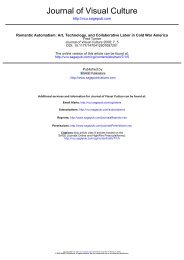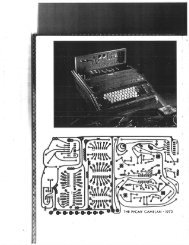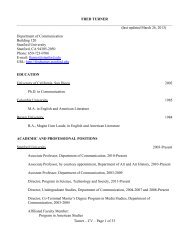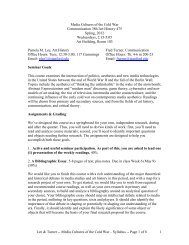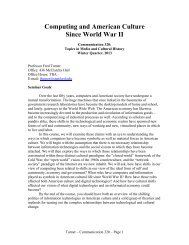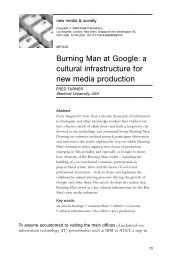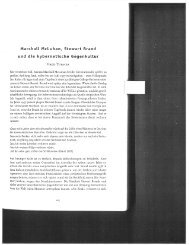The Family of Man and the Politics of Attention in ... - Public Culture
The Family of Man and the Politics of Attention in ... - Public Culture
The Family of Man and the Politics of Attention in ... - Public Culture
Create successful ePaper yourself
Turn your PDF publications into a flip-book with our unique Google optimized e-Paper software.
<strong>Public</strong> <strong>Culture</strong><br />
By today’s st<strong>and</strong>ards, such an <strong>in</strong>novation might seem mild, even trivial. From<br />
a time <strong>in</strong> which digital screens bombard us with images from every conceivable<br />
angle <strong>and</strong> <strong>in</strong> places as diverse as football stadiums, airplanes, <strong>and</strong> bedrooms, it is<br />
difficult to imag<strong>in</strong>e how important Bayer’s new strategy actually was. In addition<br />
to mark<strong>in</strong>g a shift <strong>in</strong> <strong>the</strong> techniques <strong>of</strong> museum display, it embraced <strong>and</strong> made<br />
visible an entirely non- Freudian <strong>the</strong>ory <strong>of</strong> media reception. With<strong>in</strong> most accounts<br />
<strong>of</strong> mass media at <strong>the</strong> time, only <strong>the</strong> makers <strong>of</strong> messages enjoyed <strong>in</strong>dependent<br />
agency <strong>in</strong> select<strong>in</strong>g <strong>and</strong> mak<strong>in</strong>g mean<strong>in</strong>gful sequences <strong>of</strong> images <strong>and</strong> sounds.<br />
<strong>The</strong>ir messages entered <strong>the</strong> m<strong>in</strong>ds <strong>of</strong> <strong>the</strong>ir audiences through <strong>the</strong> trapdoor <strong>of</strong> <strong>the</strong><br />
unconscious first spotted by Freud <strong>and</strong> left those m<strong>in</strong>ds fractured <strong>and</strong> irrational.<br />
With<strong>in</strong> Bayer’s extended field <strong>of</strong> vision, however, fragments <strong>of</strong> media surrounded<br />
viewers — viewers who <strong>in</strong> turn reached out to <strong>the</strong> images <strong>the</strong>y saw, select<strong>in</strong>g,<br />
arrang<strong>in</strong>g, <strong>and</strong> <strong>in</strong>tegrat<strong>in</strong>g <strong>the</strong>m <strong>in</strong> <strong>the</strong>ir m<strong>in</strong>ds <strong>in</strong>to <strong>the</strong>ir own <strong>in</strong>dividual gestalts.<br />
In Bayer’s work, viewers took charge <strong>of</strong> both <strong>the</strong> view<strong>in</strong>g process <strong>and</strong> <strong>the</strong> construction<br />
<strong>of</strong> <strong>the</strong>ir psyches. As a result, at least <strong>in</strong> <strong>the</strong>ory, viewers became more<br />
<strong>in</strong>dependent <strong>and</strong> psychologically whole.<br />
At <strong>the</strong> Bauhaus, this sort <strong>of</strong> <strong>in</strong>dividual <strong>in</strong>tegration formed <strong>the</strong> heart <strong>of</strong> <strong>the</strong> curriculum.<br />
<strong>The</strong> founders <strong>of</strong> <strong>the</strong> Bauhaus hoped to produce <strong>in</strong>dustrial- age artists who<br />
could <strong>in</strong>tegrate multiple materials <strong>in</strong>to <strong>the</strong>ir production <strong>and</strong> multiple senses <strong>in</strong>to<br />
<strong>the</strong>ir perceptions. In 1930s Paris, Bayer’s extended field <strong>of</strong> vision transformed <strong>the</strong><br />
Bauhaus ideal <strong>of</strong> pr<strong>of</strong>essional <strong>in</strong>tegration <strong>in</strong>to an act <strong>of</strong> apperception. In New York<br />
<strong>in</strong> 1942, Bayer’s field became a tool for <strong>the</strong> psychological <strong>and</strong> social <strong>in</strong>tegration<br />
<strong>of</strong> a new k<strong>in</strong>d <strong>of</strong> American citizen. By grant<strong>in</strong>g American viewers high degrees<br />
<strong>of</strong> agency with regard to <strong>the</strong> visual materials around <strong>the</strong>m <strong>and</strong> at <strong>the</strong> same time<br />
controll<strong>in</strong>g <strong>the</strong> shape <strong>of</strong> <strong>the</strong> field <strong>in</strong> which <strong>the</strong>y might encounter those materials,<br />
Bayer <strong>and</strong> Steichen could lead <strong>the</strong>m to remake <strong>the</strong>ir own morale <strong>in</strong> terms set by<br />
<strong>the</strong> field around <strong>the</strong>m. That is, American viewers could exercise <strong>the</strong> <strong>in</strong>dividual<br />
psychological agency on which democratic society depended <strong>and</strong> so avoid becom<strong>in</strong>g<br />
<strong>the</strong> numb mass men <strong>and</strong> women <strong>of</strong> Nazi Germany. At <strong>the</strong> same time, <strong>the</strong>y<br />
could do so <strong>in</strong> terms set by <strong>the</strong> needs <strong>of</strong> <strong>the</strong> American state, articulated <strong>in</strong> <strong>the</strong><br />
visual diction <strong>of</strong> Bayer’s extended field.<br />
Bayer designed Road to Victory as a road, curv<strong>in</strong>g through <strong>the</strong> entire second<br />
floor <strong>of</strong> <strong>the</strong> Museum <strong>of</strong> Modern Art <strong>and</strong> w<strong>in</strong>d<strong>in</strong>g by images <strong>and</strong> texts <strong>of</strong> vary<strong>in</strong>g<br />
sizes. When <strong>the</strong>y entered, visitors encountered a floor- to- ceil<strong>in</strong>g photograph<br />
<strong>of</strong> Utah’s Bryce Canyon <strong>and</strong> huge portraits <strong>of</strong> three Native American men. <strong>The</strong><br />
words “road to victory” floated over <strong>the</strong>ir heads on nearly <strong>in</strong>visible wires. A<br />
text by S<strong>and</strong>burg translated <strong>the</strong> images <strong>in</strong>to words: “In <strong>the</strong> beg<strong>in</strong>n<strong>in</strong>g was virg<strong>in</strong><br />
68



